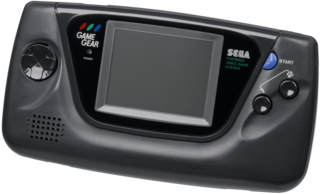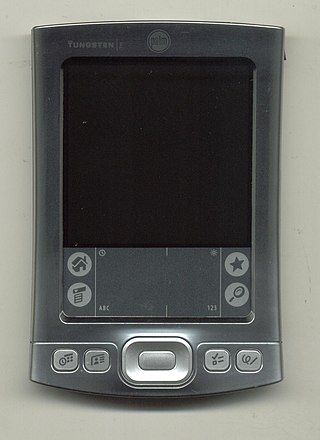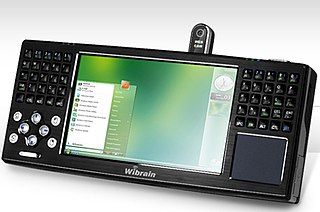
The Game Boy Advance (GBA) is a 32-bit handheld game console developed, manufactured, and marketed by Nintendo as the successor to the Game Boy Color. It was released in Japan on March 21, 2001, in North America on June 11, 2001, in the PAL region on June 22, 2001, and in mainland China as iQue Game Boy Advance on June 8, 2004.

A handheld game console, or simply handheld console, is a small, portable self-contained video game console with a built-in screen, game controls and speakers. Handheld game consoles are smaller than home video game consoles and contain the console, screen, speakers, and controls in one unit, allowing players to carry them and play them at any time or place.

The Game Gear is an 8-bit fourth-generation handheld game console released by Sega on October 6, 1990 in Japan, in April 1991 throughout North America and Europe, and during 1992 in Australia. The Game Gear primarily competed with Nintendo's Game Boy, the Atari Lynx, and NEC's TurboExpress. It shares much of its hardware with the Master System, and can play Master System games through the use of an adapter.

Amstrad was a British consumer electronics company, founded in 1968 by Alan Sugar. During the 1980s, the company was known for its home computers beginning with the Amstrad CPC and later also the ZX Spectrum range after the Sinclair deal, which led it to have a substantial share of the PC market in Britain. In the following decade it shifted focus towards communication technologies, and its main business during the 2000s was the manufacture of satellite television set-top boxes for Sky, which Amstrad had started in 1989 as the then sole supplier of the emerging Sky TV service.

Sinclair, Inc., doing business as Sinclair Broadcast Group, is a publicly traded American telecommunications conglomerate that is controlled by the descendants of company founder Julian Sinclair Smith. Headquartered in the Baltimore suburb of Cockeysville, Maryland, the company is the second-largest television station operator in the United States by number of stations, after Nexstar Media Group, owning or operating 193 stations across the country in over 100 markets, covering 40% of American households. It is the largest owner of stations affiliated with Fox, NBC, CBS, ABC, MyNetworkTV, and The CW. Sinclair owns four digital multicast networks, Comet, Charge!, The Nest, and TBD, and sports-oriented cable networks, Stadium, Tennis Channel, and Bally Sports Regional Networks. In June 2021, Sinclair became a Fortune 500 company, having reached 2020 annual revenues of US$5.9 billion, equivalent to $6.8 billion in 2023.

A television set or television receiver is an electronic device for viewing and hearing television broadcasts, or as a computer monitor. It combines a tuner, display, and loudspeakers. Introduced in the late 1920s in mechanical form, television sets became a popular consumer product after World War II in electronic form, using cathode-ray tube (CRT) technology. The addition of color to broadcast television after 1953 further increased the popularity of television sets in the 1960s, and an outdoor antenna became a common feature of suburban homes. The ubiquitous television set became the display device for the first recorded media for consumer use in the 1970s, such as Betamax, VHS; these were later succeeded by DVD. It has been used as a display device since the first generation of home computers and dedicated video game consoles in the 1980s. By the early 2010s, flat-panel television incorporating liquid-crystal display (LCD) technology, especially LED-backlit LCD technology, largely replaced CRT and other display technologies. Modern flat-panel TVs are typically capable of high-definition display and can also play content from a USB device. In the late 2010s, most flat-panel TVs began offering 4K and 8K resolutions.

Kojak is an American action crime drama television series starring Telly Savalas as the title character, New York City Police Department Detective Lieutenant Theophilus "Theo" Kojak. Taking the time slot of the popular Cannon series, it aired on CBS from 1973 to 1978.

The Tungsten series was Palm, Inc.'s line of business-class Palm OS-based PDAs.
Sinclair Radionics Ltd was a company founded by Sir Clive Sinclair in Cambridge, England which developed hi-fi products, radios, calculators and scientific instruments.
The history of video game consoles, both home and handheld, began in the 1970s. The first console that played games on a television set was the 1972 Magnavox Odyssey, first conceived by Ralph H. Baer in 1966. Handheld consoles originated from electro-mechanical games that used mechanical controls and light-emitting diodes (LED) as visual indicators. Handheld electronic games had replaced the mechanical controls with electronic and digital components, and with the introduction of Liquid-crystal display (LCD) to create video-like screens with programmable pixels, systems like the Microvision and the Game & Watch became the first handheld video game consoles.

WPGH-TV is a television station in Pittsburgh, Pennsylvania, United States, affiliated with the Fox network. It is owned by Sinclair Broadcast Group alongside dual CW and MyNetworkTV affiliate WPNT. The two stations share studios on Ivory Avenue in the city's Summer Hill neighborhood, where WPGH-TV's transmitter is also located.

The XGP was a concept portable video game system created by the Korean company GamePark as the follow-up to its GP32 handheld. Initially announced in 2005, the XGP was finally announced in March 2006 along with the release of the similar XGP Mini and the XGP Kids. The company went bankrupt before releasing any of the models.
WPMT is a television station licensed to York, Pennsylvania, United States, serving as the Fox affiliate for the Susquehanna Valley region. Owned by Tegna Inc., the station maintains studios on South Queen Street in Spring Garden Township. Through a channel sharing agreement with Harrisburg–licensed PBS member WITF-TV, the two stations transmit using WITF-TV's spectrum from an antenna in Susquehanna Township.

WHNT-TV is a television station in Huntsville, Alabama, United States, affiliated with CBS. It is owned by Nexstar Media Group alongside Florence-licensed CW owned-and-operated station WHDF. The two stations share studios on Holmes Avenue Northwest in downtown Huntsville; WHNT-TV's transmitter is located on Monte Sano Mountain. The station also operates three news bureaus: Decatur, Sand Mountain (Albertville), and Shoals (Florence).

An ultra-mobile PC, or ultra-mobile personal computer (UMPC), is a miniature version of a pen computer, a class of laptop whose specifications were launched by Microsoft and Intel in Spring 2006. Sony had already made a first attempt in this direction in 2004 with its Vaio U series, which was only sold in Asia. UMPCs are generally smaller than subnotebooks, have a TFT display measuring (diagonally) about 12.7 to 17.8 centimetres, are operated like tablet PCs using a touchscreen or a stylus, and can also have a physical keyboard. There is no clear boundary between subnotebooks and ultra-mobile PCs, but UMPCs commonly have major features not found in the common clamshell laptop design, such as small keys on either side of the screen, or a slide-out keyboard.
A handheld television is a portable device for watching television that usually uses a TFT LCD or OLED and CRT color display. Many of these devices resemble handheld transistor radios.

The Nintendo DSi is a dual-screen handheld game console released by Nintendo. The console launched in Japan on November 1, 2008, and worldwide beginning in April 2009. It is the third iteration of the Nintendo DS, and its primary market rival was Sony's PlayStation Portable (PSP). The fourth iteration, entitled Nintendo DSi XL, is a larger model that launched in Japan on November 21, 2009, and worldwide beginning in March 2010. Development of the DSi began in late 2006, and the handheld was unveiled during an October 2008 Nintendo conference in Tokyo. Consumer demand convinced Nintendo to produce a slimmer handheld with larger screens than the DS Lite. Consequently, Nintendo removed the Game Boy Advance (GBA) cartridge slot to improve portability without sacrificing durability.

The PlayStation Vita is a handheld game console developed and marketed by Sony Computer Entertainment. It was first released in Japan on December 17, 2011, then in other international territories on February 22, 2012, and was produced until discontinuation on March 1, 2019. The console is the successor to the PlayStation Portable (PSP), and a part of the PlayStation brand of gaming devices; as part of the eighth generation of video game consoles, it primarily competed with the Nintendo 3DS.
The Yaesu VX series is a line of two sequences of compact amateur radio handheld transceivers produced by Yaesu. There is a line of ultra-compact lower-power dual-band transceivers that started with the VX-1R and was later updated with the VX-2R and VX-3R. There is also a line of 5 W tri-band transceivers that started with the VX-5R and was later updated with the VX-6R, VX-7R and VX-8R.

The attempted acquisition of Tribune Media by Sinclair Broadcast Group was a proposed broadcast media transaction between Sinclair Broadcast Group and Tribune Media. Formally announced on May 8, 2017, the $3.9 billion deal would have resulted in Sinclair owning—or having operational control over—stations available in 72% of all households with a television set in the United States.
















